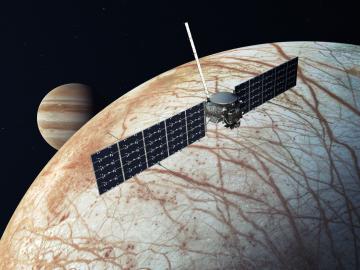
Filter News
Area of Research
- (-) Neutron Science (22)
- (-) Nuclear Systems Modeling, Simulation and Validation (1)
- (-) Supercomputing (76)
- Advanced Manufacturing (3)
- Biological Systems (1)
- Biology and Environment (46)
- Computational Biology (2)
- Computational Engineering (3)
- Computer Science (6)
- Electricity and Smart Grid (3)
- Energy Science (65)
- Fuel Cycle Science and Technology (1)
- Functional Materials for Energy (1)
- Fusion and Fission (30)
- Fusion Energy (10)
- Isotope Development and Production (1)
- Isotopes (12)
- Materials (34)
- Materials for Computing (3)
- Mathematics (1)
- National Security (26)
- Nuclear Science and Technology (38)
- Quantum information Science (1)
- Sensors and Controls (2)
News Topics
- (-) Big Data (23)
- (-) Biomedical (28)
- (-) Grid (5)
- (-) High-Performance Computing (44)
- (-) Mathematics (2)
- (-) Nuclear Energy (8)
- (-) Security (7)
- (-) Space Exploration (5)
- 3-D Printing/Advanced Manufacturing (10)
- Advanced Reactors (3)
- Artificial Intelligence (40)
- Bioenergy (14)
- Biology (16)
- Biotechnology (2)
- Buildings (4)
- Chemical Sciences (7)
- Clean Water (2)
- Composites (1)
- Computer Science (99)
- Coronavirus (19)
- Critical Materials (3)
- Cybersecurity (9)
- Energy Storage (14)
- Environment (29)
- Exascale Computing (26)
- Fossil Energy (1)
- Frontier (33)
- Fusion (2)
- Hydropower (1)
- Isotopes (2)
- Machine Learning (17)
- Materials (28)
- Materials Science (33)
- Microscopy (8)
- Molten Salt (1)
- Nanotechnology (19)
- National Security (8)
- Neutron Science (122)
- Partnerships (1)
- Physics (17)
- Polymers (3)
- Quantum Computing (20)
- Quantum Science (30)
- Simulation (16)
- Software (1)
- Summit (43)
- Transportation (10)
Media Contacts

A new version of the Energy Exascale Earth System Model, or E3SM, is two times faster than an earlier version released in 2018.

A team of scientists led by the Department of Energy’s Oak Ridge National Laboratory and the Georgia Institute of Technology is using supercomputing and revolutionary deep learning tools to predict the structures and roles of thousands of proteins with unknown functions.

Neuromorphic devices — which emulate the decision-making processes of the human brain — show great promise for solving pressing scientific problems, but building physical systems to realize this potential presents researchers with a significant

The world is full of “huge, gnarly problems,” as ORNL research scientist and musician Melissa Allen-Dumas puts it — no matter what line of work you’re in. That was certainly the case when she would wrestle with a tough piece of music.

An international problem like climate change needs solutions that cross boundaries, both on maps and among disciplines. Oak Ridge National Laboratory computational scientist Deeksha Rastogi embodies that approach.

Improved data, models and analyses from ORNL scientists and many other researchers in the latest global climate assessment report provide new levels of certainty about what the future holds for the planet

An ORNL-led team comprising researchers from multiple DOE national laboratories is using artificial intelligence and computational screening techniques – in combination with experimental validation – to identify and design five promising drug therapy approaches to target the SARS-CoV-2 virus.

Researchers from NASA’s Jet Propulsion Laboratory and Oak Ridge National Laboratory successfully created amorphous ice, similar to ice in interstellar space and on icy worlds in our solar system. They documented that its disordered atomic behavior is unlike any ice on Earth.

The Department of Energy’s Oak Ridge National Laboratory has licensed its award-winning artificial intelligence software system, the Multinode Evolutionary Neural Networks for Deep Learning, to General Motors for use in vehicle technology and design.

Scientists have found new, unexpected behaviors when SARS-CoV-2 – the virus that causes COVID-19 – encounters drugs known as inhibitors, which bind to certain components of the virus and block its ability to reproduce.


